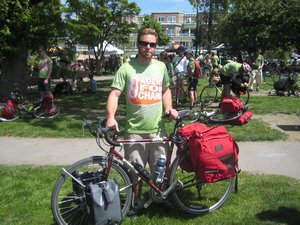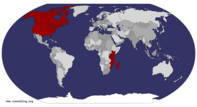Advertisement
Published: October 12th 2009

 Launch Day
Launch Day
Don't worry I wore a helmet when I was riding...Breaking the Cycle
In November of 2008, I was accepted by Global Agents for Change to participate in its third annual Ride to Break the Cycle. I was tasked with cycling from Vancouver to Mexico to raise both money and awareness for microcredit. Microcredit is the extension of very small loans to developing world entrepreneurs, and is a cause that continues to inspire me. Over the months that followed, I would discover the power of relationships, and the potential that personal connections have in creating effective solutions to many of the world’s problems.

What initially drew me to the ride was the cause. The concept of microcredit is simple. Borrowers form small groups of 3-6 individuals, and each create basic business plans. A small loan, usually $50 or less, is then granted to each. Unlike conventional lending, no collateral is required. Furthermore, due to the high administrative costs that accompany such small loans, interest rates are typically much higher than conventional bank loans. Despite this, international payback rates range from 97-99.5%, and the majority of borrowers graduate from their initial loan to withdraw further loans of greater value. While forms of microfinance have been around for centuries,

 The Hub
The Hub
Our second night. Practically a 3-star hotel.the current model of microcredit-style lending can inarguably be traced back to the Grameen Bank in Bangladesh. Founded in the 1970’s by Muhammad Yunus, the Grameen Bank used trust and familiarity as its main form of collateral. Lending primarily to women, and utilizing their already developed skills, the Grameen Bank achieved exceptionally high rates of payback immediately. Since then, the model has proliferated throughout the developing world, and forms of it can now be found in Canada, the United States, and Britain.
Global Agents for Change (GAFC) was founded in 2006 as a social change catalyst, driving sustainable solutions to global poverty. While their main focus is microcredit, they also run education and youth oriented projects. The emphasis is always on helping people help themselves, understanding that handouts are not typically sustainable solutions, whereas opportunity and education are.
The ride itself was physically draining, mentally stimulating, and a whole lot of fun. Eighteen of us began our journey in downtown Vancouver on May 31st, amidst plenty of support from friends and family. While my parents couldn’t be there, all was forgiven, as on the same day my Mom was dragon boating in Venice to raise awareness

 Sunny Washington
Sunny Washington
Normally we tried to avoid riding in the middle of the highway.for both breast cancer and the environment. My bike trip lasted six weeks. The majority of our accommodations were prearranged, and while we were responsible for carrying our own gear, we also had a support vehicle. The van, nicknamed the “Honey Bucket”, was home to camping gear, groceries, injured and sick riders, and was invariably a giant mess.

As unforgettable as the cycling was, our days off, which were every five or six days, were even more memorable. The first four days of riding took us to our first day off in Seattle. Those first days were long and hot, and we made many wrong turns as we all got accustomed to life on the road. Highlights included our Peace Arch ultimate frisbee match, and ripping down the gorgeous tree-lined highway south of Bellingham with Kyle. Kyle was our host, as well as the owner of the Hub bicycle cooperative. The legacy of the Hub remained with us throughout the trip, as did the 20 free water bottles given to us by Kyle.

Our next day off came in Newport, Oregon, where four of us had the opportunity to do a live interview for the local
radio station. The riding between Seattle and Newport gave us a taste of what the rest of the trip would look like: gorgeous, hilly coastline, dotted with quaint small towns and isolated national parks. Crossing the Astoria Bridge from Washington into Oregon was as awe-inspiring as it was difficult.

From Newport, Oregon, to Arcata, California, was perhaps the most beautiful and diverse stretch of the trip. The Oregon Coast Highway stunned us with its tree-lined cliffs and white sand beaches, while crossing into California meant riding down the Redwood Highway, amongst the largest living creatures on earth. As anyone who has driven this section of the coast knows well, chainsaw carvings are ubiquitous, and the tag-line “world-famous” accompanies anything from treehouses to giant shoes. Not to mention an enormous Paul Bunyan and Blue. Like, really big.

We were given two days off in San Francisco, to give our bodies and bottoms a few days rest. San Fran is also the headquarters of Kiva, an organization which facilitates online lender-borrower relationships, primarily from the developed world to the developing world. Kiva’s headquarters were exactly how you picture a large scale not-for-profit organization: hectic, messy, and full of

 Astoria Bridge
Astoria Bridge
Take a good hard look at that bridge, and then imagine riding acoss/up it.brilliant minds. Over half their staff are unpaid interns. All of our questions were answered comprehensively, and we had many, as Kiva is the organization through which GAFC has channelled most of their money over the years. Because of the inefficiency of managing such a large amount of money through such small loans, however, GAFC has recently decided to offer one time grants to microfinance institutions. These grants may be used to set up functioning computer systems, hire administrative staff, or enhance local infrastructure, anything which allows the microfinance institution to attract more capital and expand its base of borrowers.

Following our days off in San Francisco, we had six days of riding until our next day off in San Luis Obispo. This took us from the surf of Santa Cruz, to the postcard-worthy beauty of Monterey and Carmel, and up into Big Sur National Park. While in the middle of Big Sur, and conveniently out of cell phone range, a spoke on my back wheel broke, rendering it unrideable. Luckily, a fellow rider already with hitchhiking experience on the ride, was with me. We were immediately picked up by four military men, in uniform, on leave.

 Oregon Coast
Oregon Coast
Just a taste of the beauty.
After our day off in charming San Luis Obispo, it was four days of riding before our next scheduled day off in Santa Monica. With the hills mostly behind us, the time came to battle the heat. Despite the heat, the riding here was as glorious as you might imagine. It was only made better by the occasional glimpse of dolphins swimming along the coast. In one of the few scheduling errors that occurred, we ended up riding into Santa Monica without anywhere to stay. The benefit of being a cyclist is that there is an entire community of cyclists watching out for you all along the coast. Sure enough, that afternoon, another touring cyclist stopped two of our riders to inquire about our ride. After finding out we were homeless for the evening, he managed to find us a dance studio on Electric Avenue with a floor to crash on. We then decided to leave a day early for Dana Point, our next stop, and have our day off there. We spent the day renting surfboards, lying on the beach, playing a twilight softball game, being overfed and spoilt by the community of Dana Point, and greeted

 Another taste
Another taste
Awe-inspiring view, and mind-blowing to think we were riding further than the eye could see. Much further.by both the city director and Mayor. Unsurprisingly, Dana Point won our trip-end award for “Best Place to Stay”.

Because of the scheduling error, only two days remained until the border. A day to San Diego, and then on to the border. Ordinarily, we rode in pods of 2-5 individuals. Our ride from San Diego to the border, however, was as a full team. I was on the phone with my mom enrolling in classes for the fall as we rolled up to the border, and only had a few minutes to mentally prepare myself for our arrival. There was an eery silence as we dismounted our bikes and approached the gates, as if we were expecting all of Mexico to pause and acknowledge our presence. Once we had settled, many hugs and high fives were exchanged, and yet still the heavy border traffic failed to notice us. The anticipated highlight of the trip turned out to be rather anticlimactic. A few minutes later, as we were getting our group picture taken, a bus from the U.S. was arriving at the border full of illegal immigrants, forcing its occupants back into Mexico. This occurs everyday, multiple times a

 More coast
More coast
The view never really gets old. The biking sometimes did.day. These individuals are forced to return to Tijuana, a city now notorious for its drug-trafficking and violent crime. I found myself wondering what, exactly, I had just accomplished. An impressive athletic feat? Undoubtedly. A physical and mental grind, worthy of praise? Perhaps. But did this ride truly make a difference to the lives of those whom we were trying to affect? Only time will tell.

One of the criticisms of microcredit, and there are many, is that its macrolevel success has yet to be proven. Anecdotal evidence is plentiful, but how many times can we hear about a Tanzanian garment worker, or a Bengali bamboo stool-maker, without wondering if the economies, or the lives, within these communities, are improving? While I once embraced this criticism, I now challenge it. One thing this ride taught me is the power and potency of trust. Much like the beginnings of microcredit, our ride relied on trust, and trust can only be built upon personal relationships. Conventional economics operates on parameters that too frequently overlook factors such as trust, and quality of life, relying instead on collateral and reciprocity. Successful microcredit initiatives are implemented using different guidelines, and therefore success should

 Sandboarding
Sandboarding
Perhaps the most overrated adventure sport in the world.be measured differently as well. Maybe because of your $50 loan or donation, that Tanzanian garment worker was able to buy a new loom, and employ her two sisters. Maybe her business keeps her off the street, or helps her purchase HIV medication for a loved one. Maybe knowing that is enough. For many, it isn’t. However I maintain that if these small steps are the only ones that we understand, and that will take us forward, then slowly, but surely, we should continue to take them.
Thank you to everyone who supported me on my ride. I learned a great deal about the network of friends and family I have while preparing for the ride, and couldn’t have done it without every one of you. I hope you all learnt something about the initiative of microcredit, and that I have engendered a drive to learn more. If you’re curious, please check out the following websites, and if you have any questions, as always, please feel free to contact me.

Advertisement
Tot: 0.123s; Tpl: 0.013s; cc: 6; qc: 44; dbt: 0.0375s; 1; m:domysql w:travelblog (10.17.0.13); sld: 1;
; mem: 1.1mb




















